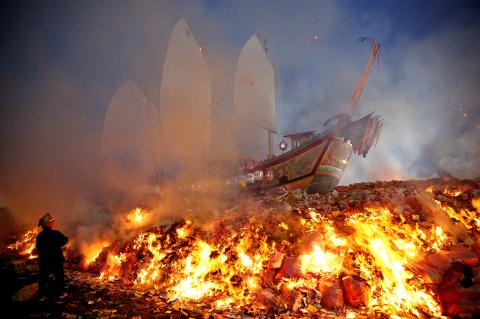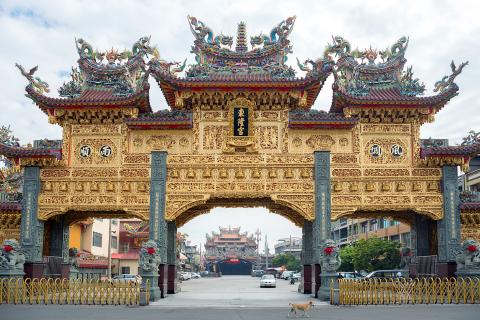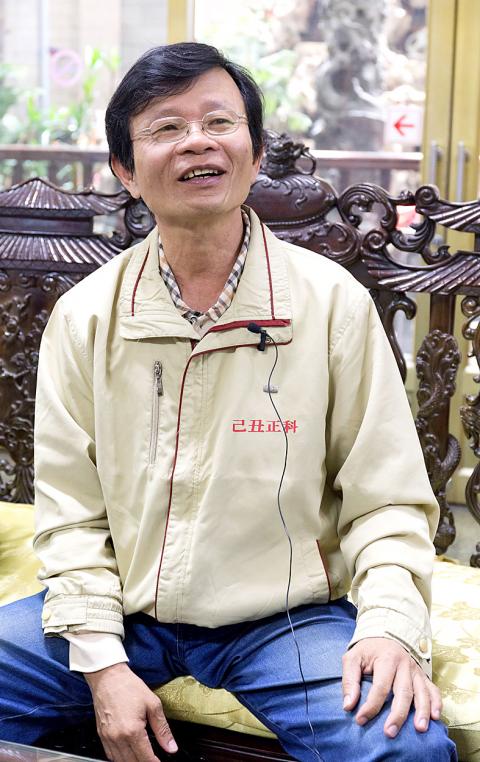The King Boat (王船) has company this year. A smaller replica sits in a concrete building across the plaza at Donglong Temple (東隆宮), where it will remain on display long after the real deal is burnt in November.
“We will keep this one permanently so future generations will know what we once had,” temple director Tsai Tsai-an (蔡財安) says.
The burning of the wooden boat, which is over 13-meters long and functional, is the highlight of a week of events in Pingtung County’s Donggang (東港) to celebrate the arrival of five deities known as the Wangyeh (王爺, or Royal Lords) from across the sea. In the name of the Jade Emperor, these lords will rid the land of diseases and evil spirits while punishing the bad and rewarding the good. Held every three years, the next one will take place in late October.

Photo: Perry Svensson, Taipei Times
The boat was completed in August last year, however, as it is customary for the temple to display it for about a year for visitors to worship. It takes a rotating crew of 70 to 80 people three to four months to complete the ship, but Tsai says the skill is being lost as the youngest craftsman is in his 60s. They were still able to replace chief shipbuilder and designer Hsieh Chun-cheng (謝春成) after his death shortly before the boat’s completion, but the future seems murky.
“We used to have hundreds of traditional boat builders here in Donggang,” Tsai says. “But why would young people learn this skill? They can’t use it to make a living,” noting that today’s fishing boats are made from fiberglass reinforced plastic using completely different methods.
Lin Shu-shan (林樹山), 70, has been building fishing vessels since his teens. He’s taken part in every King Boat construction after the ceremony switched from paper ships to wooden ones in 1973.

Photo: Perry Svensson, Taipei Times
“All our boats were made out of wood, so we thought, ‘Why can’t our ceremonial boat be wooden as well?’” Tsai says. “So we had a meeting and decided to do that.”
While the boat is colorful and contains wooden carvings of sailors, livestock and other offerings, Lin says the structural process is more or less the same as a functional fishing boat, although they are styled after traditional Chinese boats from the Ming Dynasty.
“We used to do this every day,” Lin says. “But now it’s every three years. Some people get old and start forgetting.”

Photo: Perry Svensson, Taipei Times
Tsai is part of the group that makes the sails for the boat, which is also a lost art, he says.
“Even I never used sails during my career as a fisherman. I had to learn from my father, as we started switching to engines in the 1930s and 1940s,” he says.
Tsai says there is yet to be a solution to pass on the skill. They could pay young people a salary to serve as apprentices, but he says that it’s not something that can be learned in a short period.

photo: Perrv Svensson, Taipei Times
“Our apprenticeships were more than three years long,” he says. “And when they’re done, they still can’t use what they learned to further their career. Plus, it’s hard work. Young people don’t want to do that these days.”
Tsai says if this goes on, the temple may have to revert to paper or plywood boats in order to continue.
Lin laughs when asked his opinion on what should be done.
“I’ll leave it up to the Wangyeh,” he says.

May 11 to May 18 The original Taichung Railway Station was long thought to have been completely razed. Opening on May 15, 1905, the one-story wooden structure soon outgrew its purpose and was replaced in 1917 by a grandiose, Western-style station. During construction on the third-generation station in 2017, workers discovered the service pit for the original station’s locomotive depot. A year later, a small wooden building on site was determined by historians to be the first stationmaster’s office, built around 1908. With these findings, the Taichung Railway Station Cultural Park now boasts that it has

Wooden houses wedged between concrete, crumbling brick facades with roofs gaping to the sky, and tiled art deco buildings down narrow alleyways: Taichung Central District’s (中區) aging architecture reveals both the allure and reality of the old downtown. From Indigenous settlement to capital under Qing Dynasty rule through to Japanese colonization, Taichung’s Central District holds a long and layered history. The bygone beauty of its streets once earned it the nickname “Little Kyoto.” Since the late eighties, however, the shifting of economic and government centers westward signaled a gradual decline in the area’s evolving fortunes. With the regeneration of the once

In February of this year the Taipei Times reported on the visit of Lienchiang County Commissioner Wang Chung-ming (王忠銘) of the Chinese Nationalist Party (KMT) and a delegation to a lantern festival in Fuzhou’s Mawei District in Fujian Province. “Today, Mawei and Matsu jointly marked the lantern festival,” Wang was quoted as saying, adding that both sides “being of one people,” is a cause for joy. Wang was passing around a common claim of officials of the People’s Republic of China (PRC) and the PRC’s allies and supporters in Taiwan — KMT and the Taiwan People’s Party — and elsewhere: Taiwan and

Even by the standards of Ukraine’s International Legion, which comprises volunteers from over 55 countries, Han has an unusual backstory. Born in Taichung, he grew up in Costa Rica — then one of Taiwan’s diplomatic allies — where a relative worked for the embassy. After attending an American international high school in San Jose, Costa Rica’s capital, Han — who prefers to use only his given name for OPSEC (operations security) reasons — moved to the US in his teens. He attended Penn State University before returning to Taiwan to work in the semiconductor industry in Kaohsiung, where he